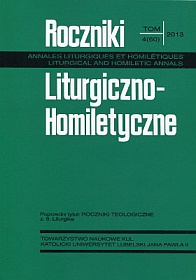Tożsamość prezbitera w świetle wybranych homilii Benedykta XVI (2005-2011)
Abstrakt
Nauczanie Benedykta XVI podczas udzielania święceń prezbiteratu czy innych okazji potwierdza teologiczną prawdę o centralnym miejscu gestu nałożenia rąk i modlitwy w obrzędach święceń. Papież akcentuje fakt całkowitego włączenia prezbitera w Chrystusa i Jego życie. Niesie to za sobą udział w misji, jaką Jezus powierzył apostołom. Przez sakrament święceń prezbiter zostaje namaszczony, konsekrowany, czyli ofiarowany Bogu. Wyraża się to w byciu dyspozycyjnym Bogu i Kościołowi. Prezbiter powinien aktualizować tę dyspozycyjność każdego dnia swojej posługi. W refleksji nad znaczeniem obrzędów wyjaśniających święcenia (włożenie szat kapłańskich i namaszczenie dłoni), Papież wskazuje na analogię pomiędzy sakramentem chrztu i święceń. Wyraża się to w odzianiu w szaty liturgiczne, które oznacza przyobleczenie się w Chrystusa. Jest ono także aktualizacją „tak” wypowiedzianego Zbawicielowi przez święcenia. Analiza modlitw towarzyszących niegdyś przy ubieraniu szat liturgicznych pozwala określić duchową dyscyplinę prezbitera, której zachowywanie pozwoli być autentycznym świadkiem i sługą Chrystusa. Narzędziami służby prezbitera są jego dłonie, namaszczone olejem świętego krzyżma. Ich zadaniem jest przekazywanie Boskiego dotyku. Namaszczenie sprawia, że prezbiter ma udział w namaszczeniu Chrystusa.
Bibliografia
Araszczuk S.: Duchowość kapłańska. „Roczniki Teologiczne” 49:2002 z. 8 s. 45-52.
Cieślik P.: Prezbiter jako sługa w świetle odnowionego po Soborze Watykańskim II Pontyfikału Rzymskiego. Studium teologiczno-liturgiczne. Warszawa: UKSW 2010/2011.
Cieślik P.: Prezbiter jako sługa. Sandomierz: Wydawnictwo Diecezji Sandomierskiej 2011.
Czerwik S.: Tożsamość i posługiwanie kapłana według „Lex orandi” typicznego wydania obrzędów święceń z roku 1990 oraz jego polskiej edycji z roku 1999. „Roczniki Teologiczne” 49:2002 z. 8 s. 17-43.
Greger P.: Pasterska służba we wspólnocie Kościoła na podstawie liturgii sakramentu święceń. „Bielsko-Żywieckie Studia Teologiczne” 12:2011 s. 69-78.
Jagodziński M.: Trwały skutek przyjęcia sakramentu święceń. „Collectanea Theologica”. 74:2004 z. 3 s. 77-89.
Krakowiak Cz.: Kapłan reprezentuje czyli uobecnia Chrystusa, głowę Kościoła. W: Ante Deum stantes. Red. S. Koperek. Kraków: Wydawnictwo PAT UNUM 2002 s. 301-316.
Krakowiak Cz.: Święcenia prezbiterów w Pontyfikale rzymskim z 1990 roku. W: Kapłan pośród ludu kapłańskiego. (Homo meditans XIV). Red. W. Słomka, J. Misiurek. Lublin: TN KUL 1993 s. 97-98.
Kwiatkowski D.: Święcenia prezbiterów w Pontyfikale Rzymskim z 1990 roku. „Roczniki Teologiczne” 49:2002 z 8 s. 111-144.
Matwiejuk K.: Prezbiterat w świetle obrzędów święceń. W: Sacerdos alter Christus. Kapłan w życiu i posłudze Kościoła na progu trzeciego tysiąclecia. Księga jubileuszowa z okazji siedemdziesiątych urodzin ks. prof. zw. dr. hab. Władysława Nowaka. Red. S. Ropiak. Olsztyn: Wydział Teologii Uniwersytetu Warmińsko-Mazurskiego w Olsztynie 2010. s. 149-159.
Stefański J.: Kalendarium prac nad pierwszym i drugim wydaniem typicznym Pontyfikału Rzymskiego De ordinatione z 1968 i 1990 roku. „Roczniki Teologiczne” 49: 2002 z. 8 s. 65-96.

